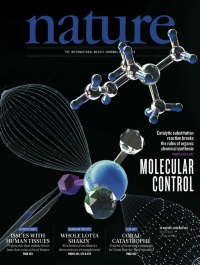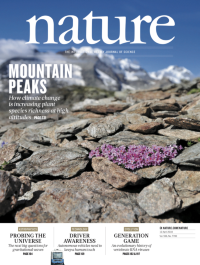Volume 556
-
No. 7702 26 April 2018
Molecular controlCarbon atoms with four different carbon substituents — quaternary stereocentres — are key structural motifs in biologically active small organic molecules. These molecules can have distinct mirror images and synthesizing only the correct configuration can be a challenge. In this issue Eric Jacobsen and his colleagues reveal how they selectively produced quaternary stereocentres from a racemic mixture using a reaction mechanism that usually cannot be controlled. The unimolecular nucleophilic substitution (SN1) reaction is ubiquitous in organic chemistry textbooks. It allows an incoming nucleophile to replace one of the existing substituents on a carbon atom via a planar cationic intermediate (featured on the cover). But the nature of the mechanism means that the nucleophile can approach the reactive carbon atom from either face meaning that it is usually impossible to add the incoming group selectively. By using a chiral hydrogen-bonding catalyst and a Lewis acid Jacobsen and his team have broken that rule allowing the SN1 reaction to progress in a stereocontrolled fashion.
-
No. 7701 19 April 2018
Particle reflectionAdvances in nanofabrication have enabled studies of chirality to extend from conventional ‘mirror image’ molecules seen in organic chemistry to three-dimensional metallic nanostructures. Similar to their organic counterparts these metallic structures display optical activity with each mirror-image form interacting differently with circularly polarized visible light. This optical activity is rooted in plasmonic effects which derive from the way the structures’ morphology affects oscillations of electrons in the material. In this issue Ki Tae Nam and his colleagues demonstrate a solution-based method for synthesizing homogenous highly chiral gold nanoparticles and controlling their respective chiral properties. The researchers induce chirality by growing the gold in the presence of cysteine or cysteine-based peptides which enantioselectively bind to high-index crystallographic planes of the gold seeds. The process could lead to new opportunities in chiral sensing and active colour displays.
-
No. 7700 12 April 2018
Mountain peaksThe cover shows the Alpine rock jasmine (Androsace alpina) in the scree of Piz Lagalb in the eastern Alps. Mountains are experiencing some of the highest rates of warming under anthropogenic climate change. In this issue, Manuel Steinbauer and his colleagues examine how plant species richness has changed over the past 145 years on 302 mountain summits across Europe. Using vegetation survey data, the researchers find that richness increased strongly on the vast majority of Europe’s summits over this period. They note, however, that the rate of increase has accelerated over time, with five times as much species enrichment occurring in the past decade compared with fifty years ago. Their analysis reveals a positive correlation between the magnitude of the increase in richness and the rate of warming, suggesting that climate-induced biotic change is accelerating even in remote places on Earth.
Spotlight
-
No. 7699 5 April 2018
The cover depicts a scanning electron microscope image of quantum-well infrared photodetectors created from a metamaterial array of metallic resonators. Technologies for the detection of infrared radiation in the long-wavelength range (8-12 micrometres) exist, but devices that are both very fast and sensitive require low-temperature operation, which limits their applications. In this issue, Daniele Palaferri and his collaborators show how photonic metamaterial ideas combined with the high speed of quantum-well infrared photodetectors leads to an ultrasensitive coherent detection, similar to that developed for radio waves: heterodyne detection. This enhanced sensitivity for the detection of long-wavelength infrared radiation at room temperature potentially opens up a range of applications, from thermal imaging and environmental remote sensing to coherent free-space communications. Cover image: Daniele Palaferri & Stephane Suffit/University Paris-Diderot




